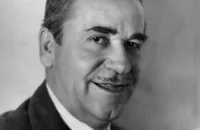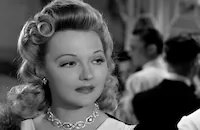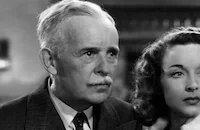Mystery Liner
Brief Synopsis
Cast & Crew
William Nigh
Noah Beery
Astrid Allyn
Edwin Maxwell
Gustav Von Seyffertitz
Ralph Lewis
Film Details
Technical Specs

Synopsis
The day before the ocean liner Guthrie is to sail on an experimental voyage, Captain Holling, who has been suffering from an exotic mental disorder, is declared unfit for duty by shipowner Watson and ordered ashore. Before Chief Mate Downey assumes command, he and First Officer Cliff Rogers learn about the mission and the "S-505," a radio tube device that will enable its inventor, Professor Grimson, to control the movements of the liner from shore. That night, after Grimson is strangled and almost killed, the leader of an enemy government sends an unseen agent to "keep an eye on" another agent already on board the Guthrie . In turn, Watson orders Major Pope, a private detective, to board the ship in order to investigate any suspicious passengers. After ship physician Dr. Howard reveals that Holling was poisoned with a tropical drug, Pope begins to question Downey and Cliff. News of Holling's mysterious appearance in the cabin of elderly Mrs. Plimpton is echoed by the suspicious movements of German passenger Von Kessling. Hours before the S-505 test, Downey is killed as he tries to send a televised message to Watson on shore. As Pope questions Cliff and Von Kessling about Downey's murder, nurse Lila Kane reveals that Downey had stolen a library book about voodoo medicine, implicating him in Holling's poisoning. During the scheduled S-505 demonstration, Grimson extinguishes the ship's lights, and in the darkness, the S-505 is stolen, the ship is immobilized, and Mrs. Plimpton is terrorized by frantic fighting in her cabin. Once the lights are restored, Captain Holling steps out of a secret door in Mrs. Plimpton's cabin and discloses that he and agent Von Kessling were tracking down Major Pope, the real murderous agent, who is then arrested.

Director
William Nigh
Cast

Noah Beery

Astrid Allyn
Edwin Maxwell
Gustav Von Seyffertitz
Ralph Lewis
Cornelius Keefe
Zeffie Tilbury
Boothe Howard

Howard Hickman
Jerry Stewart

George Hayes
George Cleveland
John Maurice Sullivan
Gordon Demaine
Olaf Hytten
Ray Brown
George Nash
Crew

Film Details
Technical Specs

Articles
Mystery Liner
The latest voyage for a luxury liner called the Guthrie proves to be anything but routine thanks to a new captain, Downey (Boothe Howard), stepping in for the recently institutionalized and apparently insane Captain John Holling (Noah Beery), sent away under the orders of ship physician Dr. Howard (Gone with the Wind's [1939] Howard Hickman). Complicating matters further is the onboard presence of the S-505, a very modern gadget developed by Professor Grimson (Ralph Lewis) who intends to test out its ability to remotely control ships out on the ocean, with potentially world-changing results. An attack on the professor's life brings in a private eye and former Army commander (Ninotchka's [1939] Edwin Maxwell) who deduces that someone with murderous intent is not only after the S-505 but using the forces of dark magic to bring down his foes...
While the Wallace source novel is packed with incident and a number of outlandish elements usually reserved for science fiction and horror yarns, Mystery Liner is still a Monogram film through and through, which means lots of exposition and just enough creepy elements involved to keep things interesting. The studio often made a practice of cross-pollinating its genres, most notably with "creepy westerns" like Haunted Ranch (1943), and Wallace's material proved enough of a fit to balance out dialogue scenes in limited settings with fantastic but simple story elements to keep viewers wondering exactly where the story was heading.
One common Monogram tactic was signing an affordable marquee name for an extremely brief shooting period to keep down costs, and in this case Noah Beery (brother of Wallace Beery) came aboard as the voodoo-afflicted and possibly spectral Captain Holling, whose brief but memorable appearances bookend the storyline. A screen actor from the very earliest days of silents, Beery had appeared in such successes as Tol'able David (1930) and She Done Him Wrong (1933), not to mention steady employment as the baddie in dozens of westerns. Best remembered for a supporting role in Frank Capra's Mr. Smith Goes to Washington (1939), stage and screen actress Astrid Allwyn has a rare leading role here as Lila Kane, the ship's nurse over whom all the red-blooded males seem to be fighting. However, the most familiar face for many movie buffs is only seen in a few quick scenes; beloved western movie sidekick George Hayes can be glimpsed as Joe the watchman, four years before he took on the more famous screen name of "Gabby" Hayes ("Yer dern tootin'!") and regularly appeared with John Wayne and Roy Rogers, even inspiring a comic book based on his horse-riding exploits.
The director of Mystery Liner, William Nigh, was also a longstanding veteran of the silent era having worked in features all the way back to 1914. Though not an auteur by any stretch, he was a very quick filmmaker averaging at least four to five films per year, a skill Monogram found extremely useful. His affinity for the mysterious and macabre went on to serve him well with such films as Boris Karloff's Mr. Wong cycle (Mr. Wong Detective [1938],Doomed to Die [1940],The Mystery of Mr. Wong [1939],The Fatal Hour [1940],Mr. Wong in Chinatown [1939]), The Ape (1940), and the eccentric 1942 Bela Lugosi vehicle, Black Dragons. By the early '40s he moved back up to bigger studios like Universal with efficient second-billers such as Lionel Atwill's The Strange Case of Doctor Rx and one of Anna May Wong's strongest later talkies, Lady from Chungking (both 1942).
As for the already deceased Edgar Wallace, Mystery Liner proved seaworthy enough to justify further Monogram adaptations of his work, most notably 1940's Chamber of Horrors with Leslie Banks (adapted from The Door with Seven Locks) and The Human Monster with Bela Lugosi (adapted from The Dark Eyes of London). This title wasn't their only stab at a literary adaptation from 1933 to 1934 either, as they also churned out budget-hampered but interesting versions of Black Beauty, Oliver Twist, Jane Eyre and The Moonstone. However, Monogram's versions marked the end of the first wave of Wallace films, with interest quickly fading out through the 1940s and '50s. However, the writer proved to be incredibly resilient as his popularity reached an all-time high throughout the '60s and '70s thanks to a lengthy string of European (mostly German) adaptations like Der Hexer (1964), The Sinister Monk (1965) and Dead Eyes of London (1961) -- which means we're due for another Edgar Wallace resurgence any day now.
Producer: Paul Malvern
Director: William Nigh
Screenplay: Wellyn Totman; Edgar Wallace (novel "The Ghost of John Holling")
Cinematography: Archie Stout
Film Editing: Carl Pierson
Cast: Noah Beery (Capt. John Holling), Astrid Allwyn (Lila Kane), Edwin Maxwell (Major Pope), Gustav von Seyffertitz (Inspector Von Kessling), Ralph Lewis (Prof. Grimson), Cornelius Keefe (First Officer Cliff Rogers), Zeffie Tilbury (Granny Plimpton), Boothe Howard (Capt. Downey), Howard Hickman (Dr. Howard), Jerry Stewart (Edgar Morton), George Hayes (Joe, the watchman), George Cleveland (Simms the Steward), John Maurice Sullivan (Watson).
BW-62m.
by Nathaniel Thompson

Mystery Liner
Quotes
Trivia
Notes
Modern sources credit Abe Meyer as musical director of the picture, and state that the sound system was Western Electric by J. R. Balsley & Joe Phillips.














